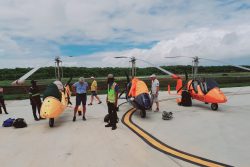(Trinidad Express) Prime Minister Kamla Persad-Bissessar has declared the north-west peninsula a disaster area.
She said immediate steps will be taken to establish an emergency relief fund for families who were affected by floods in west Trinidad.
She made the announcements on Saturday at a news briefing, flanked by several members of her Cabinet, after she toured parts of Diego Martin which were affected by heavy rains and extensive flooding.
The rains were attributed to an active Intertropical Convergence Zone (ITCZ).
The Prime Minister said rains measured up to four inches in just two hours.
She said the last time Trinidad and Tobago experienced such rainfall was in 1962.
Yesterday’s early morning, heavy rainfall caused massive flooding in Glencoe, Carenage, La Seiva, Santa Cruz and in La Puerta and Richplain in Diego Martin.
It resulted in part of the La Horquette Road in Glencoe being washed away and the Diego Martin Highway being closed off while crews from the regional corporation and private contractors cleared the debris.
Chief executive officer of the Office of Disaster Preparedness (ODPM) Dr Stephen Ramroop said a disaster area was declared “any time the impact overwhelms the capacity of the local area to deal with it and outside resources have to be called in”.
Dr Ramroop said the Diego Martin area was particularly vulnerable, having already experienced similar floods late last year.
“This area will always be impacted because there is a higher density of population and more infrastructure,” he said.
“You may see more in the future because we forecast that all over the world, there is activity like this that is going on. You saw it in England and you saw it in Russia—high intensity rain with five inches of rainfall, which you have never seen in over 34 years,” he added.
Ramroop admitted to being concerned about this country’s ability to withstand the elements.
“I am definitely concerned, which means the impact when we have a storm will be greater. But on the good side, once you see examples of this, if I have to evacuate after a storm, clearly, these are the areas I will have to evacuate,” he pointed out.
He said the country will stand a better chance of being prepared for a hurricane because there’s usually ample warning.
“I am very happy today because what I saw today was a much better integration of services, which we have tried to get since the Summit (Fifth Summit of the Americas in 2009) and CHOGM (Commonwealth Heads of Government Meeting in 2009). Once we have that level of commitment, we’ll be able to evacuate immediately,” he said.
There were swift responses from the first-responder agencies—the Diego Martin Regional Corporation, the Trinidad and Tobago Police Service, the Fire Service and the Trinidad and Tobago Defence Force—to the affected areas.
National Security Minister Jack Warner said there were over 100 Defence Force soldiers on the road while acting Commissioner of Police Stephen Williams said the Inter-Agency Task Force, the Guard and Emergency Branch and the Traffic Patrol Branch were all on alert to “preserve order in this time of need”.









